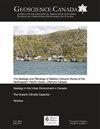Great Mining Camps of Canada 8. The Bathurst Mining Camp, New Brunswick, Part 2: Mining History and Contributions to Society
IF 0.8
4区 地球科学
Q3 GEOSCIENCES, MULTIDISCIPLINARY
引用次数: 0
Abstract
In the Bathurst Mining Camp (BMC), 12 of the 45 known massive sulphide deposits were mined between 1957 and 2013; one was mined for iron prior to 1950, whereas three others had development work but no production. Eleven of the deposits were mined for base metals for a total production of approximately 179 Mt, with an average grade of 3.12% Pb, 7.91% Zn, 0.47% Cu, and 93.9 g/t Ag. The other deposit was solely mined for gold, present in gossan above massive sulphide, producing approximately one million tonnes grading 1.79 g/t Au. Three of the 11 mined base-metal deposits also had a gossan cap, from which gold was extracted. In 2012, the value of production from the Bathurst Mining Camp exceeded $670 million and accounted for 58 percent of total mineral production in New Brunswick.Base-metal production started in the BMC in 1957 from deposits at Heath Steele Mines, followed by Wedge in 1962, Brunswick No. 12 in 1964, Brunswick No. 6 in 1965, Caribou in 1970, Murray Brook, Stratmat Boundary and Stratmat N-5 in 1989, Captain North Extension in 1990, and lastly, Half Mile Lake in 2012. The only mine in continuous production for most of this time was Brunswick No. 12. During its 49-year lifetime (1964–2013), it produced 136,643,367 tonnes of ore grading 3.44% Pb, 8.74% Zn, 0.37% Cu, and 102.2 g/t Ag, making it one of the largest underground base-metal mines in the world.The BMC remains important to New Brunswick and Canada because of its contributions to economic development, environmental measures, infrastructure, mining innovations, and society in general. The economic value of metals recovered from Brunswick No. 12 alone, in today’s prices exceeds $46 billion. Adding to this figure is production from the other mines in the BMC, along with money injected into the local economy from annual exploration expenditures (100s of $1000s per year) over 60 years. Several environmental measures were initiated in the BMC, including the requirement to be clean shaven and carry a portable respirator (now applied to all mines in Canada); ways to treat acid mine drainage and the thiosalt problem that comes from the milling process; and pioneering studies to develop and install streamside-incubation boxes for Atlantic Salmon eggs in the Nepisiguit River, which boosted survival rates to over 90%. Regarding infrastructure, provincial highways 180 and 430 would not exist if not for the discovery of the BMC; nor would the lead smelter and deep-water port at Belledune. Mining innovations are too numerous to list in this summary, so the reader is referred to the main text. Regarding social effects, the new opportunities, new wealth, and training provided by the mineral industry dramatically changed the living standards and social fabric of northern New Brunswick. What had been a largely poor, rural society, mostly dependent upon the fishing and forestry industries, became a thriving modern community. Also, untold numbers of engineers, geologists, miners, and prospectors `cut their teeth’ in the BMC, and many of them have gone on to make their mark in other parts of Canada and the world.加拿大伟大的采矿营地8。新不伦瑞克巴瑟斯特采矿营地,第2部分:采矿历史和对社会的贡献
在巴瑟斯特采矿营地(BMC),已知的45个块状硫化物矿床中有12个是在1957年至2013年间开采的;其中一个是在1950年之前开采的铁,而另外三个有开发工作,但没有生产。其中11个矿床开采贱金属,总产量约1.79 Mt,平均品位为3.12%Pb、7.91%Zn、0.47%Cu和93.9 g/t Ag。另一个矿床仅开采金,存在于块状硫化物之上的铁帽中,产生约100万吨品位1.79 g/t Au,从中提取黄金。2012年,巴瑟斯特采矿营地的生产价值超过6.7亿美元,占新不伦瑞克省总矿产产量的58%。BMC的基准金属生产始于1957年希思斯蒂尔矿山的矿床,随后是1962年的韦奇、1964年的布伦瑞克12号、1965年的布伦瑞克6号、1970年的卡里布、默里溪、Stratmat Boundary和1989年的Stratmat N-5,1990年的Captain North Extension,以及2012年的Half Mile Lake。在这段时间的大部分时间里,唯一一个持续生产的矿山是布伦瑞克12号矿山。在其49年的使用寿命(1964年至2013年)中,它生产了136643367吨矿石,品位为3.44%的Pb、8.74%的Zn、0.37%的Cu和102.2 g/t的Ag,使其成为世界上最大的地下贱金属矿之一。BMC对新不伦瑞克省和加拿大仍然很重要,因为它对经济发展、环境措施、基础设施、采矿创新和整个社会做出了贡献。仅从布伦瑞克省12号回收的金属的经济价值,以今天的价格计算,就超过460亿美元。除此之外,BMC其他矿山的产量,以及60年来每年勘探支出(每年1000美元中的100美元)注入当地经济的资金。BMC启动了几项环境措施,包括要求剃干净胡子并携带便携式呼吸器(目前适用于加拿大的所有矿山);处理酸性矿山排水和选矿过程中产生的硫盐问题的方法;以及在尼泊尔吉特河开发和安装大西洋三文鱼卵河岸孵化箱的开创性研究,将存活率提高到90%以上。关于基础设施,如果没有BMC的发现,180和430省道将不存在;贝尔杜恩的铅冶炼厂和深水港也不会。采矿创新太多了,无法在本摘要中列出,因此读者可以参考正文。关于社会影响,采矿业提供的新机会、新财富和培训极大地改变了新不伦瑞克省北部的生活水平和社会结构。曾经是一个贫穷的农村社会,主要依赖渔业和林业,现在变成了一个繁荣的现代社区。此外,无数的工程师、地质学家、矿工和探矿者在BMC“咬牙切齿”,他们中的许多人已经在加拿大和世界其他地区留下了自己的印记。
本文章由计算机程序翻译,如有差异,请以英文原文为准。
求助全文
约1分钟内获得全文
求助全文
来源期刊

Geoscience Canada
地学-地球科学综合
CiteScore
3.30
自引率
0.00%
发文量
9
审稿时长
>12 weeks
期刊介绍:
Established in 1974, Geoscience Canada is the main technical publication of the Geological Association of Canada (GAC). We are a quarterly journal that emphasizes diversity of material, and also the presentation of informative technical articles that can be understood not only by specialist research workers, but by non-specialists in other branches of the Earth Sciences. We aim to be a journal that you want to read, and which will leave you better informed, rather than more confused.
 求助内容:
求助内容: 应助结果提醒方式:
应助结果提醒方式:


